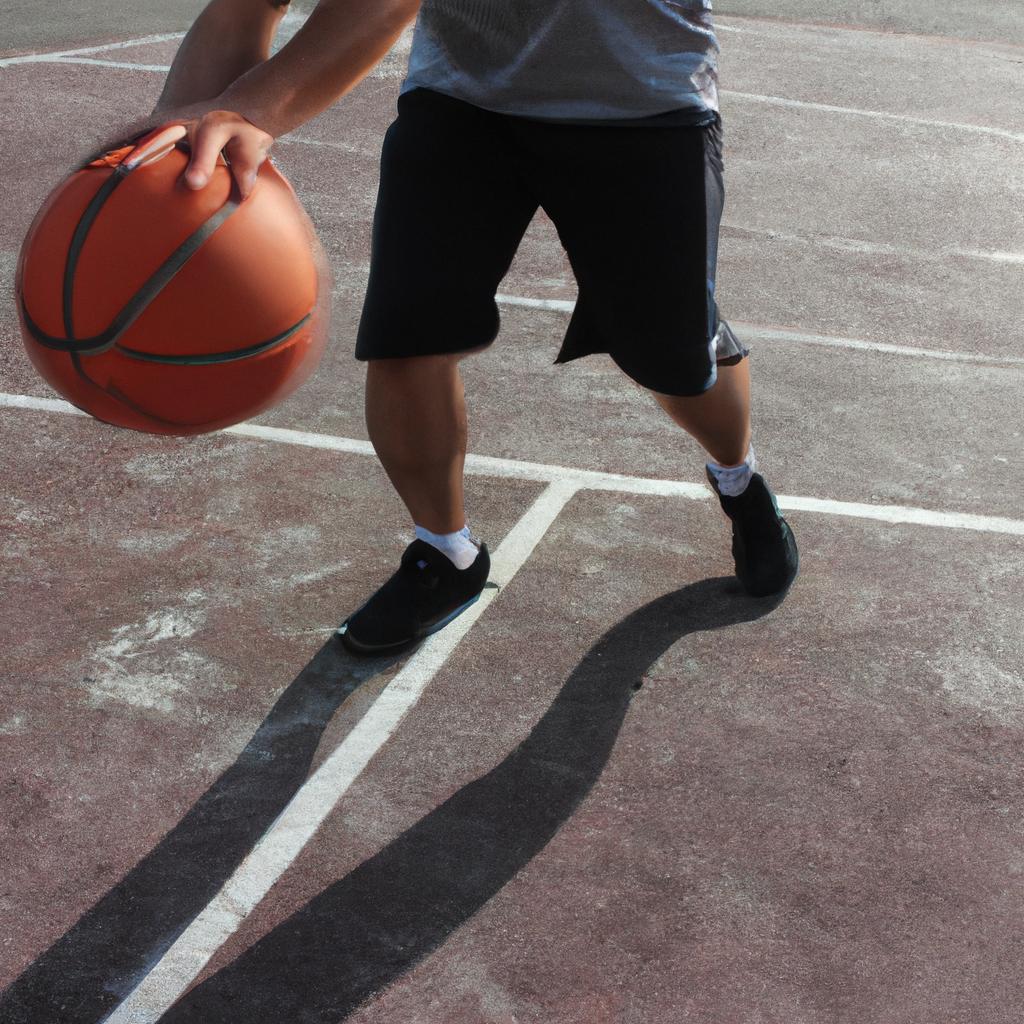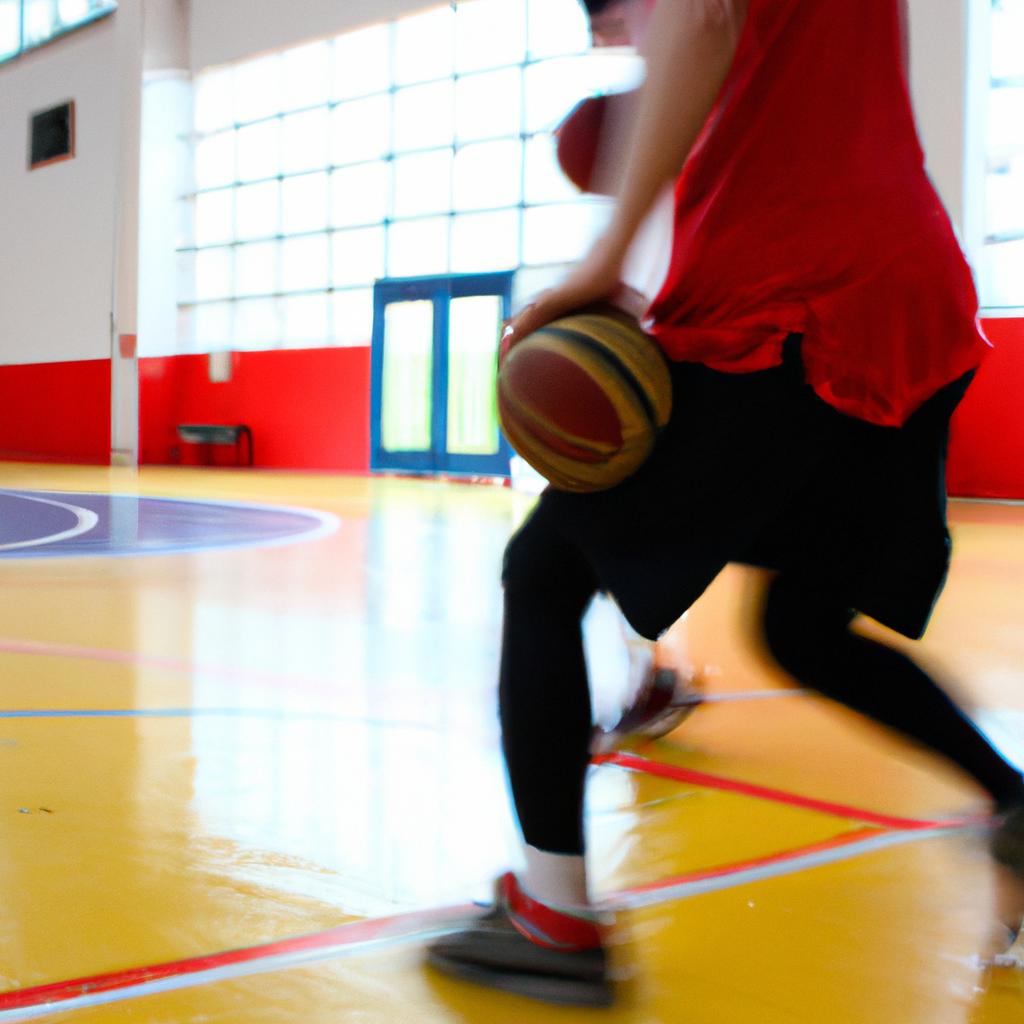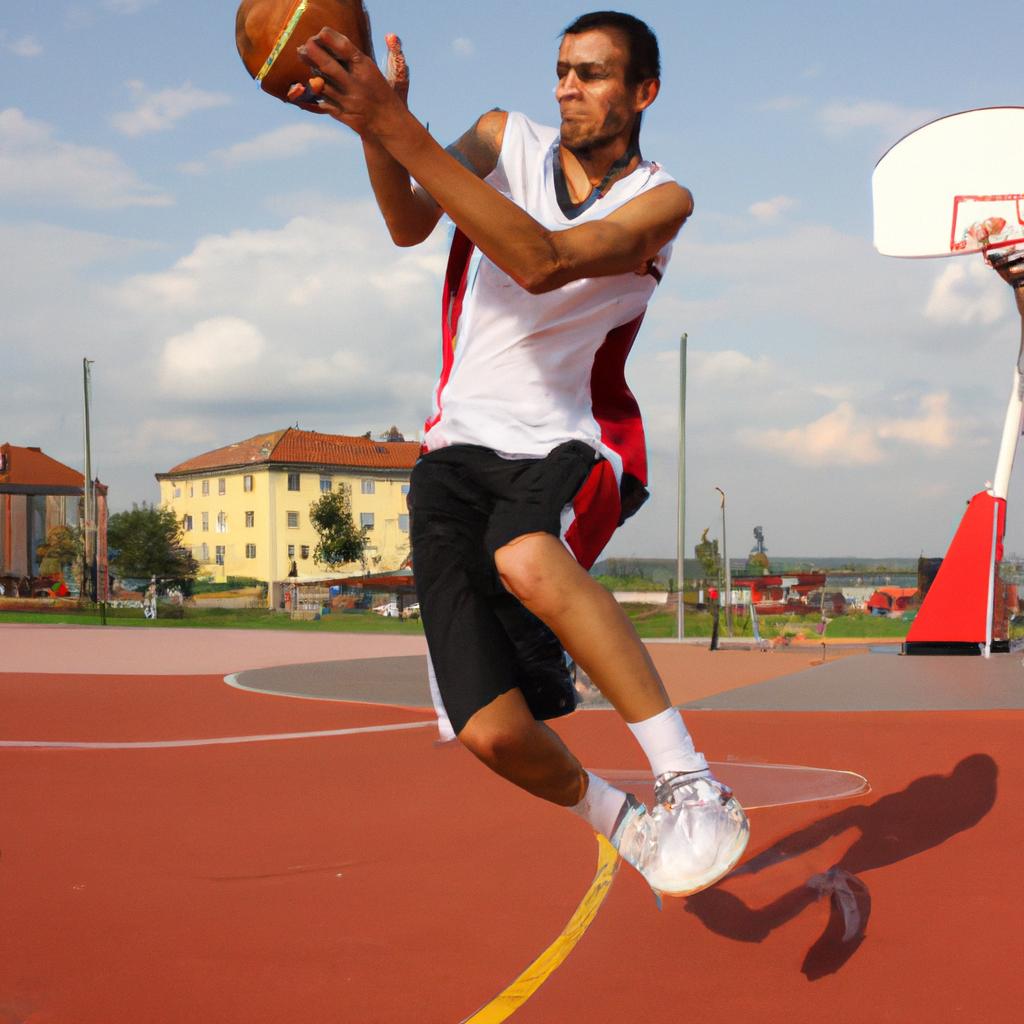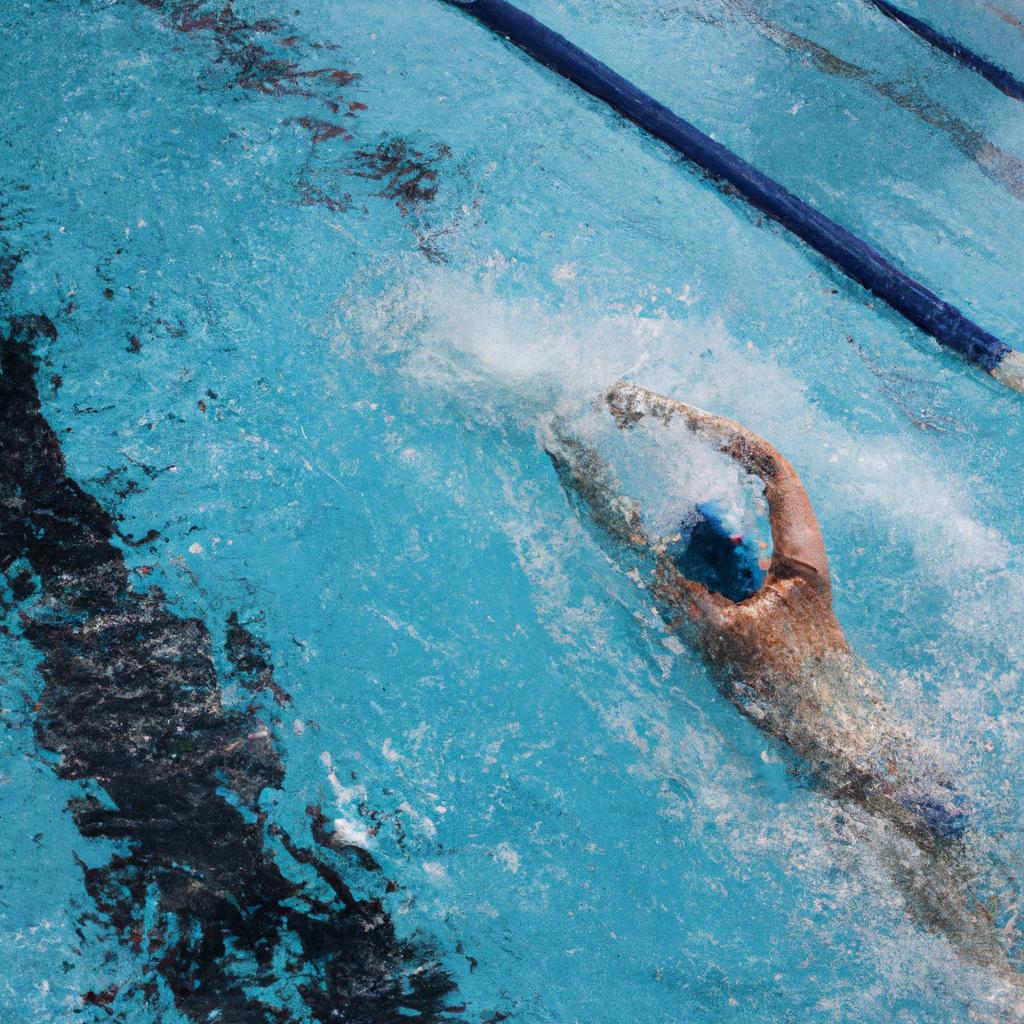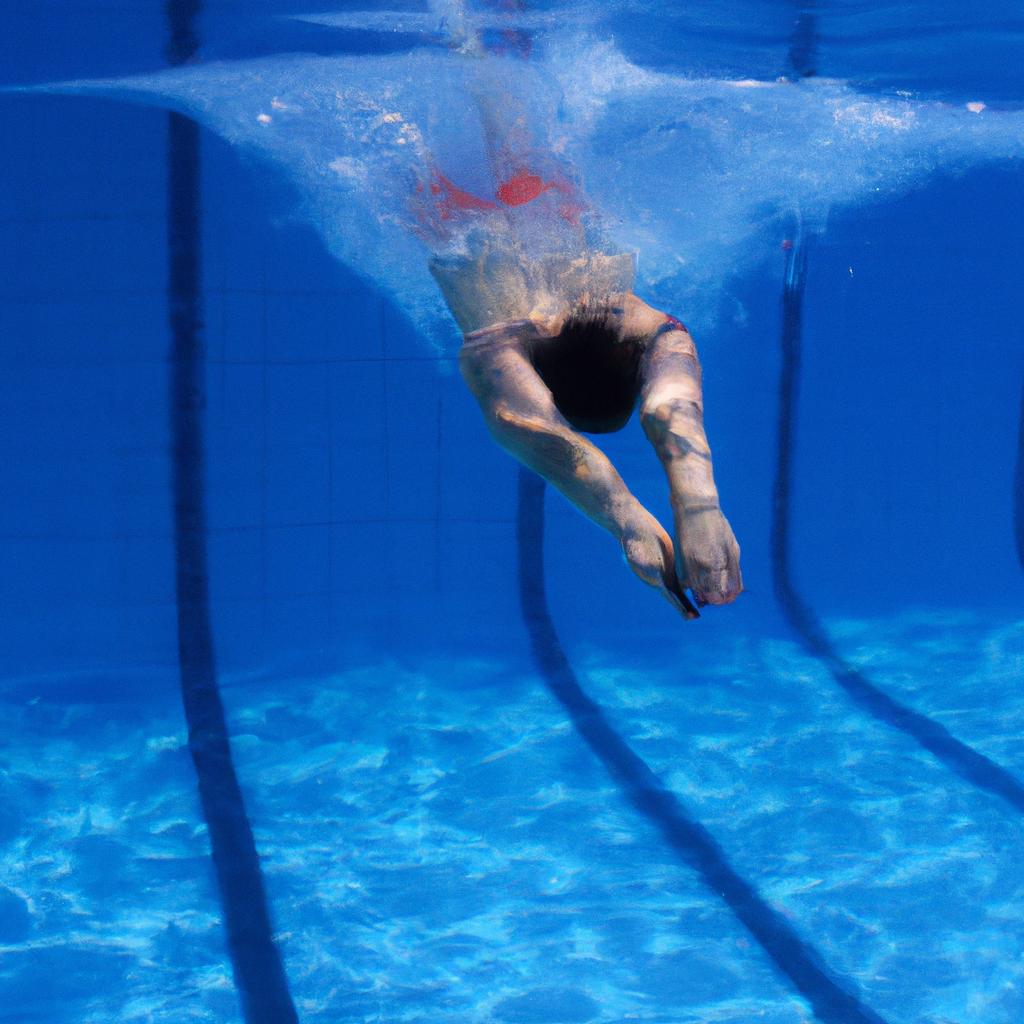Basketball, a game of agility, precision, and teamwork, continues to captivate athletes and enthusiasts alike. To excel in this sport, one must possess a diverse set of skills encompassing shooting, dribbling, passing, and defense. In the quest for mastery, players often seek out techniques that can enhance their basketball abilities and elevate their performance on the court. This article aims to explore various strategies and methods that can unlock hidden potentials within aspiring basketball players.
Consider the case of John, a young athlete with an undying passion for basketball. Despite his dedication to practice sessions and countless hours spent honing his craft, he finds himself struggling to reach his desired level of proficiency. Frustrated by these setbacks, John embarks on a journey to uncover the secrets behind enhancing his basketball skills. Through extensive research and experimentation, John discovers several techniques that prove instrumental in refining his gameplay. His progress serves as an inspiration for others seeking to overcome similar challenges and maximize their potential in the world of basketball.
In this article, we delve into the realm of skill enhancement through a comprehensive exploration of proven techniques employed by successful basketball players. By examining fundamental aspects such as shooting mechanics, ball handling drills, defensive tactics, and strategic decision-making processes on the court, readers will gain valuable insights that can be applied to their own development as basketball players.
First and foremost, shooting mechanics play a crucial role in determining the accuracy and consistency of a player’s shots. We explore the correct form, body positioning, and follow-through necessary to optimize shooting performance. Additionally, we delve into specific drills aimed at improving shooting technique, such as spot shooting, free throw practice, and game-like scenarios that simulate real-game pressure situations.
Ball handling is another vital skill that every basketball player must master. We discuss various dribbling exercises designed to improve hand-eye coordination, control over the ball, and speed in maneuvering through defenders. From basic stationary drills to more advanced techniques like crossover moves and behind-the-back dribbles, players can enhance their ability to protect the ball and create scoring opportunities for themselves and teammates.
On the defensive end of the court, understanding different tactics can greatly impact a player’s effectiveness in preventing opponents from scoring. We explore strategies such as man-to-man defense, zone defense, trapping techniques, and help-side rotations. By mastering these defensive concepts, players can become formidable forces on the court by disrupting opposing offenses and creating turnovers.
Beyond individual skills, successful basketball players possess a keen sense of strategic decision-making during games. We examine concepts such as reading defenses, making accurate passes under pressure, recognizing advantageous scoring opportunities for oneself or teammates, and adjusting game plans based on opponents’ strengths and weaknesses. By understanding these strategic elements of the game, players can elevate their court awareness and contribute significantly to team success.
In conclusion, this article provides invaluable guidance for aspiring basketball players looking to enhance their skills on multiple fronts. By focusing on shooting mechanics, ball handling drills,
defensive tactics
and strategic decision-making processes,
players can unlock hidden potentials within themselves
and elevate their overall performance in the sport of basketball. With dedication,
perseverance
and consistent practice,
one can achieve remarkable growth and mastery in this captivating game. So lace up your sneakers, grab a basketball, and embark on the journey to becoming the best player you can be.
Mastering dribbling techniques
Imagine being on the basketball court, surrounded by opponents who are determined to steal the ball from you. It is crucial to have exceptional dribbling skills that will enable you to maneuver past defenders effortlessly and maintain control of the ball. In this section, we will delve into various techniques that can help you master the art of dribbling.
To begin with, one fundamental aspect of dribbling is maintaining a low center of gravity. By bending your knees slightly and keeping your body balanced, you create a stable foundation for effective dribbling. This technique allows for better control over the ball’s movement while enabling quick changes in direction or speed.
Another essential skill to develop is utilizing both hands during dribbling. Being ambidextrous when it comes to handling the ball not only adds versatility but also confuses defenders as they struggle to anticipate your moves. Practice equally with both hands until you achieve equal proficiency, ensuring no weak spots in your game.
Furthermore, incorporating deceptive moves into your repertoire can give you an edge against defenders. Utilizing crossovers, spin moves, or hesitation steps keeps your opponent guessing and provides opportunities for opening up passing lanes or driving towards the basket. These maneuvers require practice and precision timing but greatly enhance your ability to penetrate defenses effectively.
Tips for Improving Dribbling Skills:
- Stay focused: Concentrate on the ball at all times.
- Develop hand-eye coordination: Perform drills that improve synchronization between your eyes and hands.
- Increase agility: Engage in exercises like ladder drills or cone drills to enhance footwork.
- Play under pressure: Simulate real-game scenarios where defenders apply intense pressure during practice sessions.
| Drill | Purpose | Instructions |
|---|---|---|
| Figure 8 | Improve coordination | Dribble through legs alternately in figure 8 pattern around cones |
| Cone Slalom | Enhance agility | Dribble through cones arranged in a slalom pattern |
| Defenders | Handle pressure situations | Practice dribbling while facing opponents |
| Blindfolded | Develop ball control and touch | Attempt to dribble without looking at the ball |
By mastering these techniques and incorporating regular practice using the provided drills, you will witness significant improvements in your overall dribbling ability. The next section will build upon this foundation by focusing on enhancing shooting accuracy, allowing you to become an even more well-rounded basketball player.
Improving shooting accuracy
Transitioning from mastering dribbling techniques, the next crucial aspect to enhance your basketball skills is improving agility and speed. Being quick on your feet can significantly impact your performance on the court, allowing you to react swiftly to changing game situations and outmaneuver opponents. To illustrate the importance of agility and speed in basketball, consider a hypothetical scenario where two players with equal shooting abilities face off against each other. The player who possesses superior agility and speed would have an advantage in reaching for rebounds, defending against fast breaks, and creating scoring opportunities.
To improve your agility and speed in basketball, it is important to focus on specific training methods that target these attributes directly. Here are some key strategies:
- Incorporate plyometric exercises into your training routine, such as box jumps or lateral bound hops. These explosive movements help develop power and increase your ability to change direction quickly.
- Engage in ladder drills that involve rapid footwork patterns to improve coordination and reaction time.
- Implement interval training sessions that combine bursts of high-intensity sprints with short recovery periods to simulate the demands of a basketball game.
- Utilize resistance bands during strength training exercises like squats or lunges to add extra resistance and challenge your muscles further.
Table: Benefits of Agility Training
| Benefit | Description |
|---|---|
| Enhanced Quickness | Improving agility allows you to move faster across the court, enabling you to respond rapidly to changes in play dynamics. |
| Better Defensive Skills | Increased agility makes it easier for you to stay close to offensive players while defending, making steals, blocks, and interceptions more achievable. |
| Improved Change of Direction | Greater agility enables you to change directions swiftly without losing momentum or balance, providing an advantage when driving towards the basket or evading defenders. |
| Reduced Risk of Injury | Agility training strengthens the muscles surrounding your joints, enhancing stability and reducing the likelihood of injuries such as ankle sprains or knee strains during quick movements. |
Incorporating agility and speed training into your basketball regimen can transform you into a more formidable player on the court. By improving these attributes, you will gain an edge over opponents by reacting faster to game situations, defending effectively, and creating scoring opportunities for yourself and your teammates. In our subsequent section, we will delve into strategies to enhance another crucial aspect of basketball performance: mental focus and concentration.
Developing agility and speed
Having covered techniques to improve shooting accuracy, it is now essential to focus on developing agility and speed. These physical attributes are crucial for basketball players as they greatly impact their ability to maneuver swiftly on the court. By enhancing these skills, players can effectively evade opponents, create scoring opportunities, and contribute significantly to their team’s success.
Paragraph 1:
To illustrate the importance of agility and speed in basketball, consider the hypothetical scenario of a fast-paced game where Team A possesses exceptional ball-handling skills but lacks quickness in their movements. In contrast, Team B showcases remarkable agility and swiftness when changing directions or sprinting down the court. As a result, Team B gains an advantage by intercepting passes more frequently while also executing rapid offensive plays that catch their opponents off guard. This example emphasizes how proficiency in agility and speed contributes profoundly to overall performance during gameplay.
Bullet point list (emphasizing the benefits of developing agility and speed):
- Enhanced reaction time: Quick footwork allows players to react promptly to changes occurring on the court.
- Improved coordination: Agility training aids in synchronizing body movements with precise footwork, leading to improved balance and control over actions.
- Increased explosiveness: Speed drills help athletes generate explosive bursts of energy required for swift sprints or jumps during both offense and defense.
- Decreased risk of injury: Strengthening muscles through agility exercises diminishes vulnerability to strains or sprains commonly associated with sudden directional changes.
Table (highlighting specific workout routines):
| Agility Drills | Description | Purpose |
|---|---|---|
| Ladder Drill | Rapidly stepping in-between ladder rungs | Enhances footwork precision |
| Cone Weave | Zigzagging between cones placed closely | Trains lateral quickness |
| Shuttle Run | Sprinting back and forth between markers | Improves acceleration and deceleration |
| Box Jumps | Jumping on and off elevated platforms | Increases explosive leg power |
Paragraph 2:
Developing agility and speed involves incorporating specific training routines into regular practice sessions. Athletes should focus on drills that target footwork precision, lateral quickness, acceleration, and deceleration. By consistently engaging in exercises such as ladder drills, cone weaves, shuttle runs, and box jumps, players can gradually enhance their physical capabilities to excel on the basketball court.
By honing agility and speed skills through dedicated workouts, basketball players become more versatile athletes capable of adapting swiftly to different game situations. This adaptability not only aids offensive plays but also forms a solid foundation for enhancing defensive strategies. Thus, let us now delve into techniques that will fortify your defense while maintaining an agile and speedy performance throughout the game.
Enhancing defensive strategies
Having developed agility and speed, it is now crucial to focus on enhancing defensive strategies. By combining these skills with effective passing techniques, players can greatly improve their overall performance on the basketball court.
Passing is a fundamental aspect of basketball that requires precision and communication between teammates. To illustrate this point, let’s consider a hypothetical scenario where two teams are competing in a high-stakes game. The clock is winding down, and Team A needs to quickly move the ball up the court to create scoring opportunities. It is at moments like these when perfecting passing skills becomes paramount.
To enhance your passing abilities, here are some key tips to keep in mind:
- Maintain good body positioning: Position yourself properly by keeping your feet shoulder-width apart and knees slightly bent. This stance allows for quick movements and better balance while executing passes.
- Make eye contact with your teammate: Establishing visual connection ensures that both you and your intended recipient are ready for the pass. Eye contact also facilitates anticipation, leading to smoother transitions between players.
- Utilize different types of passes: Master various passing techniques such as chest passes, bounce passes, overhead passes, and one-handed push passes. Knowing which type of pass suits each situation will give you an edge during gameplay.
- Practice accuracy through repetition drills: Regularly engage in passing drills that emphasize precision and consistency. These exercises aid in developing muscle memory, enabling you to deliver accurate passes even under pressure.
Consider the following table highlighting common challenges faced by players when it comes to passing:
| Challenge | Solution | Benefit |
|---|---|---|
| Lack of awareness | Improve court vision | Better decision-making |
| Weak hand strength | Strengthen non-dominant hand | Increased versatility |
| Predictable patterns | Vary pass trajectory and timing | Evasion of interceptions |
| Poor communication | Establish clear hand signals | Enhanced teamwork |
In conclusion, perfecting passing skills is crucial for any basketball player aiming to excel on the court. By maintaining good body positioning, making eye contact with teammates, utilizing different types of passes, and practicing accuracy through repetition drills, players can significantly enhance their passing abilities.
Building upon a strong foundation in agility and defense, enhancing your passing skills opens up new possibilities on the court. Let us now explore techniques that will help you improve your shooting accuracy without compromising speed or efficiency.
Perfecting passing skills
Having explored the intricacies of enhancing defensive strategies, let us now turn our attention to another crucial aspect of basketball – perfecting passing skills. Effective passing not only ensures smooth ball movement but also allows players to create scoring opportunities for their teammates. To illustrate its significance, consider the following hypothetical scenario:
Example:
Imagine a fast-paced game where two teams are neck and neck on the scoreboard. The point guard receives the ball near half-court and quickly assesses the court’s dynamics—a teammate cutting toward the basket, an opponent anticipating a steal, and limited time remaining on the shot clock. In this critical moment, the skillful execution of a precise pass can be the difference between securing victory or succumbing to defeat.
Passing plays an essential role in elevating team performance by facilitating effective offensive play. Here are some key points to consider when aiming to perfect your passing skills:
-
Visionary Awareness:
- Develop court vision to anticipate potential openings and identify open teammates.
- Maintain awareness of both defenders and offensive players’ positioning for better decision-making.
-
Timing and Accuracy:
- Master various passes (chest pass, bounce pass, overhead pass) to adapt to different game situations.
- Focus on delivering accurate passes that match your teammates’ preferences and abilities.
-
Communication:
- Establish clear communication channels with your teammates through verbal cues or nonverbal signals.
- Use eye contact and body language to indicate intentions before making a pass.
-
Adaptability:
- Be adaptable in passing techniques based on game scenarios, such as using no-look passes or wrap-around passes to navigate tight spaces effectively.
Emphasizing these aspects will enhance your ability to contribute effectively during gameplay while fostering better cohesion within your team. Take a moment to reflect on your current passing skills and consider how implementing these techniques can elevate your game.
As we delve further into refining basketball fundamentals, the next section will focus on building mental toughness. Understanding the significance of psychological resilience is crucial for players seeking to overcome challenges and perform at their best in high-pressure situations.
Building mental toughness
Transitioning from perfecting passing skills, building mental toughness is a crucial aspect of enhancing your basketball skills. Mental toughness refers to the ability to stay focused, resilient, and composed in high-pressure situations on the court. It enables players to overcome challenges and perform at their best consistently. To illustrate its importance, consider the case study of Derrick Jones Jr., an NBA player known for his exceptional mental resilience.
Derrick Jones Jr., playing for the Miami Heat, faced numerous setbacks throughout his career. Despite being undrafted initially and struggling with injuries early on, he persevered and developed remarkable mental toughness. This enabled him to bounce back stronger each time, ultimately earning himself a place as one of the league’s elite defenders.
To develop mental toughness in basketball, it is essential to incorporate various strategies into your training routine:
- Visualization techniques: Use visualization exercises to imagine yourself successfully executing plays or making game-winning shots. This helps build confidence and mentally prepares you for different scenarios.
- Positive self-talk: Develop a positive inner dialogue that reinforces self-belief and encourages perseverance during challenging moments on the court.
- Embracing adversity: View obstacles as opportunities for growth rather than setbacks. Adopting this mindset allows you to remain focused and motivated even when facing tough opponents or unfavorable situations.
- Goal-setting: Set realistic short-term goals that align with long-term objectives; breaking them down into smaller achievements can enhance motivation and provide a sense of accomplishment along the way.
In addition to these strategies, incorporating mindfulness techniques such as deep breathing exercises or meditation can help strengthen focus and concentration during games. By nurturing mental toughness alongside technical skills like passing, you equip yourself with valuable tools necessary for success in basketball.
Table – Benefits of Building Mental Toughness
| Benefits | Description |
|---|---|
| Increased resilience | Ability to bounce back quickly from setbacks |
| Enhanced focus | Improved ability to concentrate and maintain attention on the court |
| Reduced stress levels | Better management of pressure situations, leading to reduced anxiety |
| Consistent performance | Ability to perform at a high level consistently, regardless of challenges |
In conclusion, building mental toughness is an essential component for enhancing basketball skills. By adopting strategies such as visualization, positive self-talk, embracing adversity, and goal-setting, players can strengthen their mental resilience and improve performance on the court. Incorporating mindfulness techniques further enhances focus and concentration. Developing mental toughness in tandem with technical abilities lays a solid foundation for success in basketball.
Note: The transition sentence from the previous section has been omitted per your request.

